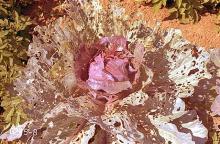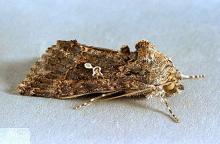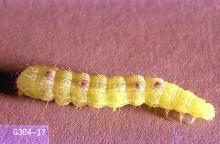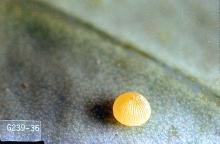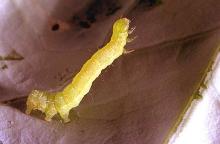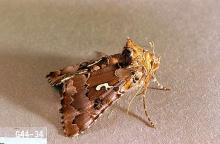Includes
Alfalfa looper (Autographa californica)
Cabbage looper (Trichoplusia ni)
Pest description and crop damage Both cabbage and alfalfa looper adults are brownish moths with distinctive silvery figures on the front wings. Eggs are ridged and dome-shaped and usually laid singly on the undersurface of leaves. Loopers are smooth-skinned with only a few long bristles down the back. They are green, usually with a narrow white stripe along each side and several narrow lines down the back. Alfalfa loopers tend to have more dark markings than cabbage loopers. Larvae may grow up to 1.5 inches long. Mature larvae spin silken cocoons and pupate, usually attached to leaves. Looper caterpillars can be distinguished from most other common caterpillars by their distinctive looping movement, in which they arch the middle portion of their body to bring the hind legs forward to meet the front legs.
Cabbage looper larvae feed on leaves, causing ragged-edged holes in the leaf and on the leaf margins. The major damage caused by larvae and pupae is contamination of the heads of cole crops and severe defoliation of alfalfa, peas, sugar beets, beans, mint, and spinach. Alfalfa loopers tend to do less physical damage to plants, but are a serious source of contamination in processing.
Biology and life history The cabbage looper overwinters as a pupa either in the soil or in trash near the base of host plants. Moths begin emerging in May, and adults lay eggs singly on plants from late May until June. Eggs hatch in about a week. Larvae feed for 3 to 4 weeks before forming a pupal cocoon attached to leaves or trash. Adults from the second generation lay eggs as before, and larvae become damaging in August. There are two generations each year.
The alfalfa looper also overwinters as a pupa either in the soil or in trash near the base of host plants. Moths begin emerging in late April and May, and adults lay eggs singly on weed hosts, usually wild crucifers, rarely on crops. Eggs hatch in 3 to 5 days, and larvae feed for about 2 weeks before pupating on the host plant or in trash. The total development time is about 30 days. Adults emerge in about 7 days, mate, and females deposit eggs as before about 3 days after emerging. There are three or four generations each year.
Pest monitoring A sweep net can be used to sample for large larvae. Take at least 100 sweeps, in groups of 10, in different parts of the field and along the margins. Sequential sampling that involves fewer samples, and presence-or-absence sampling that does not involve counting, also may be used.
Pheromone traps can be used to monitor for the emergence of adult male moths. Alfalfa loopers tend to be caught in traps more often than cabbage loopers, sometimes leading to misreadings of which looper is the primary pest. Cabbage looper is the primary contaminant for harvested broccoli and the primary target of pest control tactics. More than five cabbage looper moths per trap per day constitutes significant egg-laying pressure. More than two to five large looper worms per 100 leaves 2 to 3 weeks prior to harvest of broccoli justifies an early and aggressive spray program.
The usual situation, however, is that all stages of worms are present at the same time. Unless close inspection is made, one may be easily misled into believing only large worms present and thus encounter a serious problem at harvest time. For this reason, carefully inspect plants to determine if small worms are present. If they are, control measures should be applied.
Management-biological control
Cabbage loopers have many natural enemies that may keep them below economic levels if they are not killed by insecticide treatments for other pests. These include several important, naturally occurring parasitoids. A nucleopolyhedrovirus is also important under certain circumstances.
Be sure to monitor for natural enemies. If looper populations are close to treatment thresholds, but you find a significant percentage of parasitized or disease-killed individuals, delay treatment for a few days to see if these natural controls will bring populations down on their own. If treatment is necessary, Bacillus thuringiensis insecticide minimizes injury to natural enemies.
Management-cultural control
The use of resistant cabbage varieties such as Mammoth Red Rock, Chieftain Savoy, and Savoy Perfection Drumhead helps reduce cabbage looper damage. On most crucifers, however, chemical control of this pest becomes necessary.
Management-chemical control: HOME USE
- azadirachtin (neem oil)-Some formulations are OMRI-listed for organic use.
- Bacillus thuringiensis var. kurstaki (Btk)-Some formulations are OMRI-listed for organic use.
- bifenthrin (often as a mix with zeta-cypermethrin).
- esfenvalerate-Do not use on Brussels sprout.
- gamma-cyhalothrin
- kaolin-Applied as a spray to foliage, it acts as a repellent to some insect pests. Some formulations are OMRI-listed for organic use. Not registered for use in OR.
- permethrin
- plant essential oils (rosemary, etc.)-Some have demonstrated efficacy against lepidopteran larvae. Some formulations are OMRI-listed for organic use.
- pyrethrins (often combined with other ingredients)-Some formulations are OMRI-listed for organic use.
- spinosad-Some formulations are OMRI-listed for organic use.
- zeta-cypermethrin
Management-chemical control: COMMERCIAL USE
Control should be directed at the small worms. As the larvae reach maturity, they become difficult to control. The presence of larvae about 1 inch long indicates that development is about a week to 10 days from completion. Treatment of mature worms of cabbage or alfalfa looper within two weeks of harvest will likely have no measurable effect on yield or quality.
- acephate (Acephate 90WDG) at 1.0 lb ai/A. PHI 14 days. REI 24 hr. Do not graze or feed crop refuse to livestock. Retreatment interval 7 days. Brussels sprout and cauliflower only. Do not exceed 2 lb ai/A per year.
- alpha-cypermethrin (Fastac EC) at 0.02 to 0.025 lb ai/A. PHI 1 day. REI 12 hr. Retreatment interval 7 days. Do not exceed 0.075 lb ai/A per season.
- azadirachtin (Neemix 4.5) at 0.06 to 0.09 lb ai/A. PHI 0 days. REI 4 hr. OMRI-listed for organic use. Not registered for use in OR.
- Bacillus thuringiensis (Javelin) 0.12 to 1.5 lb/A. PHI 0 days. REI 4 hr. Slow acting. May need multiple applications. Add an appropriate spreader-sticker to enhance control. Most effective on small larvae. Some formulations are OMRI-listed for organic use.
- beta-cyfluthrin (Baythroid XL) at 0.013 to 0.019 lb ai/A. PHI 0 days. REI 12 hr. Retreatment interval 7 days. Do not exceed 0.1 lb ai/A per season.
- beta-cyfluthrin/imidacloprid (Leverage 360) at 0.07 lb ai/A. PHI 7 days. REI 12 hr. Retreatment interval 7 days. Do not exceed 0.1 lb ai/A beta-cyfluthrin or 0.2 lb ai/A imidacloprid per season.
- bifenthrin (Brigade WSB, Sniper) at 0.033 to 0.1 lb ai/A. PHI 7 days. REI 12 hr. Do not exceed 0.5 lb ai/A per year. Do not make more than five applications after bloom. Retreatment interval 7 days.
- bifenthrin/imidacloprid (Brigadier) at 0.06 to 0.095 lb ai/A. PHI 7 days. REI 12 hr. Do not exceed 0.24 lb ai/A imidacloprid and 0.24 lb ai/A bifenthrin as a foliar application. Retreatment interval 7 days. Maximum 5 treatments only after bloom.
- bifenthrin/zeta-cypermethrin (Hero EW) at 0.04 to 0.1 lb ai/A. PHI 7 days. REI 12 hr. Retreatment interval 7 days. Do not exceed 0.45 lb/A per season. Limit 5 applications after bloom.
- borate complex (Prev-Am Ultra) at 0.4% solution. Spray to complete coverage. REI 24 hr. Retreatment interval is 7 days. OMRI-listed for organic use.
- Burkholderia spp. (Venerate XC) at 1 to 4 quarts/A product. PHI 0 days. REI 4 hr. OMRI-listed for organic use.
- chlorantraniliprole (Coragen) at 0.045 to 0.098 lb ai/A a) at planting; b) via drip irrigation; c) as foliar. PHI 3 days. REI 4 hr. Retreatment interval 3 days for foliar and 10 days for drip. Do not exceed 0.2 lb ai/A per season. Consult label for details.
- chlorantraniliprole/thiamethoxam (Voliam Flexi) at 0.1 to 0.175 lb ai/A. PHI 3 days. REI 12 hr. Retreatment interval 7 days. Do not exceed 0.172 lb ai of thiamethoxam or 0.2 lb ai of chlorantraniliprole per acre per growing season.
- Chromobacterium subtsugae (Grandevo) at 0.3 to 0.9 lb ai/A per 100 gal. PHI 0 days. REI 4 hr. OMRI-listed for organic use.
- cryolite (Kryocide) at 7.7 to 15.4 lb ai/A. PHI 7 days for broccoli, cauliflower, and Brussels sprout, and 14 days for cabbage. REI 12 hr. Do not exceed 92 lb ai/A per season. Product not registered for use in OR.
- cyantraniliprole (Exirel) at 0.065 to 0.11 lb ai/A. PHI 1 day. REI 12 hr. Retreatment interval 5 days. Do not exceed 0.4 lb ai/A per year.
- cyclaniliprole (Harvanta 50SL) at 0.036 to 0.054 lb ai/A. REI 4 hr. PHI 1 day. Retreatment interval 7 days. Limit 3 treatments per crop. Do not exceed 0.22 lb ai/A per year. Some restrictions on application timing. Product not registered for use in WA.
- cyfluthrin (Tombstone) at 0.025 to 0.038 lb ai/A. PHI 0 days. REI 12 hr. Retreatment interval 7 days. Do not exceed 0.2 lb/A per season.
- cypermethrin (Holster) at 0.075 to 0.1 lb ai/A. PHI 1 day. REI 12 hr. Retreatment interval 7 days. Do not exceed 0.6 lb ai/A per season.
- emamectin benzoate (Proclaim) at 0.01 to 0.015 lb ai/A. PHI 7 days. REI 12 hr. Retreatment interval 7 days. Do not exceed 0.06 lb ai/A per season.
- esfenvalerate (Asana XL) at 0.03 to 0.05 lb ai/A. PHI 3 days. REI 12 hr. Do not use on Brussels sprout. Do not exceed 0.4 lb ai/A per year.
- fenpropathrin (Danitol 2.4EC) at 0.2 to 0.3 lb ai/A. REI 24 hr. PHI 7 days. Do not exceed 0.8 lb ai/A per season.
- flubendiamide/buprofezin (Vetica) at 0.21 to 0.42 lb ai/A. PHI 1 day. REI 12 hr. Retreatment interval 7 days. Limit 2 treatments. Do not exceed 0.84 lb ai/A per year. Product not registered for use in OR.
- gamma-cyhalothrin (Declare) at 0.0075 to 0.0125 lb ai/A. PHI 1 day. REI 24 hr. Do not exceed 0.12 lb ai/A per season. Toxic to bees.
- GS-omega/kappa-Hxtx-Hv1a (Spear Lep) at 0.02 to 0.04 lb ai/A (1 to 2 pints/A). PHI 0 days. REI 4 hr. Do not exceed 1.7 lb ai/A per year
- indoxacarb (Avaunt) at 0.045 to 0.065 lb ai/A. PHI 3 days. REI 12 hr. Use of wetting agent recommended. Retreatment interval 3 days. Do not exceed 0.26 lb ai/A per year.
- lambda-cyhalothrin (Warrior II) at 0.015 to 0.025 lb ai/A. PHI 1 day. REI 24 hr. Retreatment interval 5 days. Do not exceed 0.24 lb ai/A per year.
- lambda-cyhalothrin/thiamethoxam (Endigo ZC) at 0.064 lb ai/A. PHI 1 day. REI 24 hr. Retreatment interval 7 days. Do not exceed 0.24 lb ai of lambda-cyhalothrin or 0.172 lb ai/A of thiamethoxam per season.
- malathion (Malathion 8 Flowable) at 1.25 lb ai/A. PHI 2 days broccoli, Brussels sprout, cauliflower; 7 days for cabbage. REI 48 hr. Retreatment interval 7 days.
- methomyl (Lannate SP) at 0.45 to 0.9 lb ai/A. PHI 3 days for Brussels sprout, broccoli, and cauliflower, 1 day for cabbage, 10 days for Chinese cabbage. REI 48 hr. Do not annually exceed 5.4 lb ai/A for Brussels sprout, 6.3 lb ai/A for broccoli, and 7.2 lb ai/A for cabbage and cauliflower. Add a surfactant to improve coverage.
- methoxyfenozide (Intrepid 2F) at 0.06 to 0.12 lb ai/A for early-season application and 0.12 to 0.16 lb ai/A for mid- to late-season application or heavy infestation. REI 4 hr. PHI 1 day. Adding an adjuvant improves performance Do not exceed 1 lb ai/A per season.
- naled (Dibrom 8) at 1.8 lb ai/A. PHI 1 day. REI 48 hr. Do not exceed 9.4 lb ai/A per year. Retreatment interval 7 days. Limit 5 applications.
- novaluron (Rimon 0.83EC) at 0.039 to 0.078 lb ai/A. PHI 7 days. REI 12 hr. Retreatment interval 7 days. Do not exceed 0.156 lb ai/A per season.
- permethrin (Loveland Permethrin) at 0.05 to 0.2 lb ai/A. PHI 1 day. REI 12 hr. Do not exceed 0.8 lb ai/A per year on broccoli or 0.4 lb ai/A on Brussels sprout, cauliflower, and cabbage per season.
- spinetoram (Radiant SC) at 0.039 to 0.078 lb ai/A. PHI 1 day. REI 4 hr. Retreatment interval 4 days. Do not exceed six applications or 0.266 lb ai/A per season. Cabbage looper only. Do not apply to seedling cole crops grown for transplant within a greenhouse, shade house, or field plot.
- spinosad (Success, Entrust SC) at 0.047 to 0.094 lb ai/A. PHI 1 day. REI 4 hr. Treat eggs at hatch and small larvae. Do not exceed three times in a 30-day period. Do not exceed 0.45 lb ai/A or six applications per crop. Entrust SC is OMRI-listed for organic use.
- tebufenozide (Confirm 2F) at 0.09 to 0.12 lb ai/A early year; 0.12 lb ai/A mid to late year. PHI 7 days. REI 4 hr. Do not exceed 0.12 lb ai/A per application or 0.625 lb ai/A per year. Reapplication on a 10- to 14-day schedule may be necessary under heavy infestations. Use of a spreader-binder is recommended.
- thiamethoxam/chlorantraniliprole (Durivo) at 0.195 to 0.257 lb ai/A applied to the soil. PHI 30 days. REI 12 hr. Do not exceed 0.172 lb ai of thiamethoxam or 0.2 lb ai of chlorantraniliprole per acre per growing season.
- zeta-cypermethrin (Mustang) at 0.04 to 0.05 lb ai/A. PHI 1 day. REI 12 hr. Do not exceed 0.3 lb ai/A per year. Retreatment interval 7 days.

